Nishimeya Village, Aomori Prefecture
Incipient–Final Jōmon (approximately 15,000–2,300 years ago)
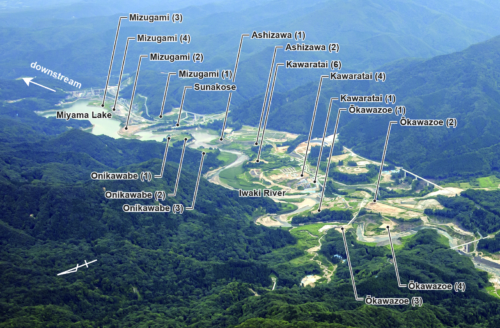
The site group seen from above Sites sit atop a terrace facing the Iwaki River as it flows down the eastern slope of the Shirakami mountain range. Adapted from Hakkutsu sareta Nihon rettō 2019 [Excavations in the Japanese Archipelago, 2019] (Bunkachō [Agency for Cultural Affairs], ed., Kyodo News, 2019). (photo courtesy of the Iwaki River Dam Operation and Management Office, Tohoku Regional Development Bureau, MLIT [Ministry of Land, Infrastructure, Transport and Tourism])
Representative Sites
Jōmon activity extending more than 10,000 years
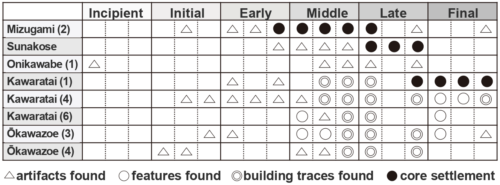
Chronological table of each site This shows the rise and fall of each site. The overall peak was from the Middle to Late Jōmon periods. It can be seen that the core settlement moved upstream over time, from Mizugami (2) to Sunakose to Kawaratai (1). Adapted from Hakkutsu sareta Nihon rettō 2019 [Excavations in the Japanese Archipelago, 2019] (Bunkachō [Agency for Cultural Affairs], ed., Kyodo News, 2019).
Mizugami (2) Site
(Latter part of the Early–initial part of the Late Jōmon)
Numerous artifacts, features are discovered at a long-standing, large-scale settlement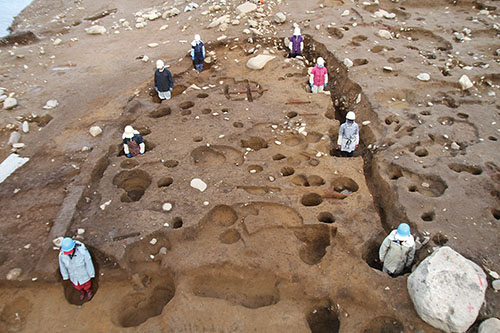
Large-scale pit-building This was discovered in the area of the midden on the northern side of the site. It was built in the latter part of the Middle period. It is an elongated oval in shape, oriented east–west, 15 m on the long axis and 7 m across. As hearths, there is a single large stone-lined hearth on the main axis, plus seven following the southern and four along the northern walls, for a total of 12 items detected.
View of investigations at stone coffin burials There were 25 stone coffin burials forming three separate groups. At one of the groups, 15 stone coffin burials were concentrated within an area 16 m east–west by 18 m north–south, with their long axes aligned and accompanied by numerous stone arrangements.
Kawaratai (1) Site
(Latter part of the Late–latter part of the Final Jōmon)
A core settlement built atop a tableland beginning from the latter part of the Late period

Plan of the distribution of features An extremely rare case in which nearly all of the settlement area was investigated. At the western midden, where there is spring water, items that normally do not survive well such as wooden artifacts, stone and antler implements, and lacquered products were recovered in large numbers. Adapted from Hakkutsu sareta Nihon rettō 2019 [Excavations in the Japanese Archipelago, 2019] (Bunkachō [Agency for Cultural Affairs], ed., Kyodo News, 2019).
Stone arrangement Stones brought from the nearby vicinity were utilized. As pit burials were detected beneath these sundial-type stone arrangements, they are thought to have been made as grave markers.
Sunakose Site
(Middle part of the Middle–latter part of the Late Jōmon)
Embedded-pillar buildings are arranged in a ring of 60 m diameter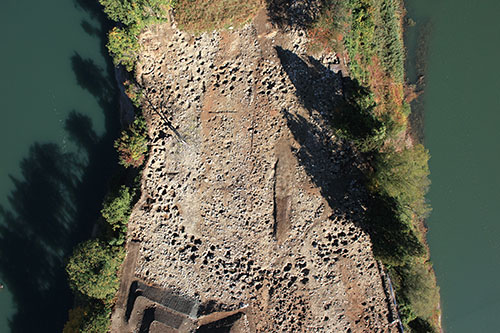
Panoramic view of the Sunakose site (north at photo top) Embedded-pillar buildings are lined up in a circular formation approximately 60 m in diameter. Pit-buildings and various pits were located outside the circle.
Clay figurines rich in expression
Showing the spiritual world of the Jōmon people
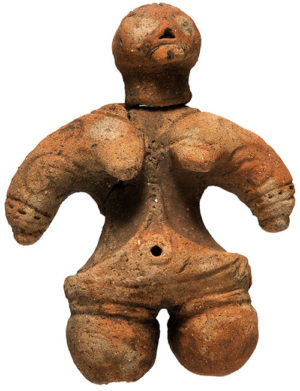 Stone-figurine-shaped clay figurine
Stone-figurine-shaped clay figurine
Kawaratai (1) site, Final period (initial part)
The face and overall form resemble stone figurines. A rare discovery of an unbroken item. Height: 14.8 cm; width: 11.2 cm; thickness: 4.2 cm; weight: 362 gm.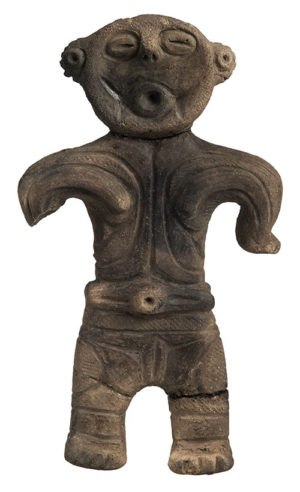
Standing clay figurine
Kawaratai (1) site, Late (latter part) to Final (initial part) periods
Nearly intact, except for the right hand. Traces of mending with asphalt are seen at the neck and left leg. Height: 20.7 cm; width: 11.2 cm; thickness: 3.2 cm; weight: 351 gm.
Masked clay figurine
Kawaratai (1) site, Final period (middle part)
The face juts forward when seen from the side, thought to represent a figure wearing a mask. Height: 21.2 cm; width: 8.2 cm; thickness: 5.5 cm; weight: 370 gm.
Crouching clay figurine, front (left) and side (right)
Kawaratai (1) site, Late (latter part) to Final (initial part) periods
Arms and kneecaps are missing. It possibly had the arms cradling the knees, or resting on the kneecaps with the hands pressed together. A well-fired, high-quality product. Height: 21.6 cm; width: 7.4 cm; thickness: 9 cm; weight: 591 gm. Adapted from Hakkutsu sareta Nihon rettō 2019 [Excavations in the Japanese Archipelago, 2019] (Bunkachō [Agency for Cultural Affairs], ed., Kyodo News, 2019).
Large-sized, slit-goggle clay figurine
Kawaratai (1) site, Final period (middle part)
Found standing upside down. The head bears a decorative item in the shape of a king’s crown, and it retains some bright red pigment. The inside is hollow. Height: 26.5 cm; width: 23.0 cm; thickness: 7.6 cm; weight: 1,115 gm.
Diverse artifacts of many kinds
Telling the prayers and daily life of the Jōmon people
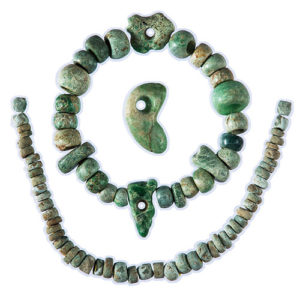 Beads
Beads
Kawaratai (4) site, Final period
Recovered from pit burials. The material is jade from Niigata Prefecture and locally produced green tuff.
Bird-shaped pot and mushroom-shaped clay object
Ōkawazoe (3) site, Middle period (latter part)
A bird-shaped pot containing red pigment was found with a mushroom-shaped clay object positioned as the lid. The bird-shaped pot is 9.2 cm high, 17.2 cm long, and 7.9 cm wide. The mushroom-shaped clay object is 5.6 cm high and 5.8 cm long. Adapted from Hakkutsu sareta Nihon rettō 2019 [Excavations in the Japanese Archipelago, 2019] (Bunkachō [Agency for Cultural Affairs], ed., Kyodo News, 2019).
Pot with clay figurine decoration
Mizugami (2) site, Middle period (initial part)
The same type of decoration found on flat clay figurines of this time has been applied. The vessel height is 16.4 cm.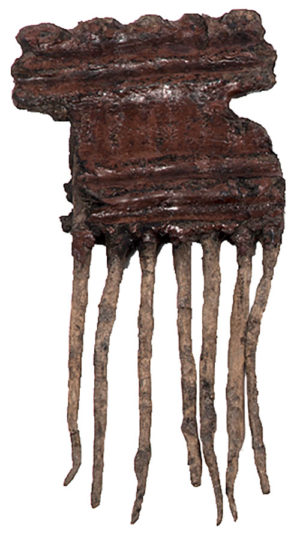
Lacquered comb
Kawaratai (1) site, Late (latter part) to Final periods
A composite comb made of several horizontal components bound at right angles with material for the teeth. The item is painted with red lacquer. The teeth are approximately 10 in number. Length: 10.1 cm; width: 4.8 cm; thickness: 0.8 cm.
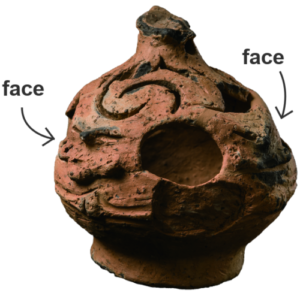
Censer-shaped pot with human faces
Kawaratai (1) site, Late (latter part) to Final periods
Human faces are fashioned on three sides of this item, which bears circular and arc-shaped openings. Soot adheres to the interior surface. Height: 11.5 cm; width: 12.7 cm; depth: 12.1 cm. Adapted from Hakkutsu sareta Nihon rettō 2019 [Excavations in the Japanese Archipelago, 2019] (Bunkachō [Agency for Cultural Affairs], ed., Kyodo News, 2019).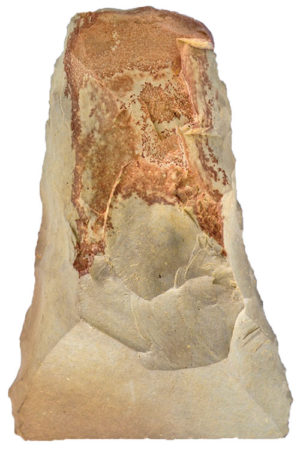
Tranchet-like stone tool
Kawaratai (4) site, Initial period
In a form resembling the plectrum of a shamisen, the sharp end portion served as a blade. Length: 6.6 cm; width: 4.3 cm; thickness: 1.7 cm.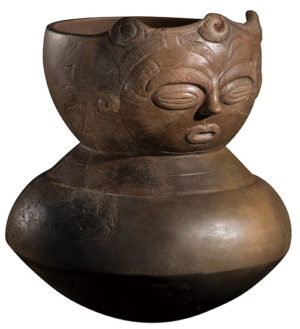
Spouted vessel with a human face
Kawaratai (1) site, start of the Final period
A face is seen depicted on the front. The vessel surface has been carefully polished and bears a shine. Height: 20.7 cm; width: 18.9; body diameter: 18.9 cm.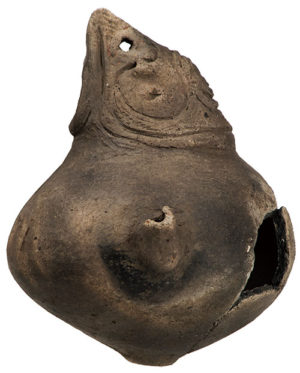
Spouted vessel with a human face
Kawaratai (1) site, Late (latter part) to Final periods
The front and back side each has a single face. The protruding top and the hole appear from an angle as the bill and eye of a bird, or perhaps as some kind of animal. Height: 10.2 cm; width: 8.3 cm; depth: 9.3 cm.
Spearheads
Onikawabe (1) site, Incipient period
Stone spearheads made of good quality siliceous shale. Such items were used as hunting gear. (Item at left) Length: 7.8 cm; width: 1.8 cm; thickness: 0.5 cm. (Item at right) Length: 6.3 cm; width: 1.7 cm; thickness: 0.6 cm.
A large site group supported by a forest’s abundance
A group of sites showing 10,000 years of Jōmon period history
Through excavations conducted from 2003 to 2015 in conjunction with the Tsugaru Dam construction project, the conditions of a group of Jōmon sites at the base of the Shirakami-Sanchi UNESCO World Natural Heritage site were revealed all at once. The site group is located on the eastern slope of the Shirakami mountain range, with most of the sites sitting atop a terrace on the south bank of the Iwaki River. There were 17 sites discovered in the excavations, from the Incipient period at the start of the Jōmon period to the Final period at its end, showing the continuous utilization of this location by Jōmon people. Enough artifacts were recovered to fill more 15,000 cardboard boxes. One portion of these sites are introduced as follows.
The rise and fall of the sites are revealed
In the Incipient period (approximately 15,000–10,000 years ago), during a time of climatic change referred to as the Late Glacial period, human occupation began in the Shirakami mountains prior to the spread of the beech forest seen in the present day. From the Onikawabe (1) site, linear-relief pottery, spearheads used as hunting gear, and end-scrapers for processing leather were recovered.
For the Initial period (approximately 10,000–7,000 years ago), dowel-impressed (oshigatamon) pottery of the initial part of the period was recovered from the Ōkawazoe (4) site, and shell-impressed (kaigaramon) pottery of the middle part of the period was found along with tranchet-like stone tools, thought to have been used as processing implements, from the Kawaratai (4) site. As patterns made with the shells of marine bivalves are seen on the pottery, it can be surmised that some form of exchange was taking place with people of the seacoast.
At the start of the Early period (approximately 7,000–5,000 years ago), traces of human activity are sparse, but in the final part of the period a large-scale settlement was being formed at the Mizugami (2) site.
In the Middle period (approximately 5,000–4,000 years ago) this trend continued. A large-scale settlement continued to be maintained at the Mizugami (2) site, and in the final part of the period large buildings exceeding 10 m in diameter made their appearance. Beginning from the period’s final part, a group of stone coffin burials was built in the center of the site, accompanied by a stone alignment feature, as the settlement continued to be maintained on a large scale. In the environs as well, numerous small-scale settlements appear from the middle part of the Middle to the initial part of the Late periods, and the total number of sites reached its peak. At the Ōkawazoe (3) site, a bird-shaped pot in which red pigment had been placed was found together with a mushroom-shaped clay object serving as a lid.
From the start of the Late period (approximately 4,000–3,000 years ago), a pottery vase decorated with a hunting motif including animal and bow-and-arrow images was recovered at the Kawaratai (6) site. For settlements, the large-scale settlement that had continued at the Mizugami (2) site from the final part of the Early period came to an end by the middle part of the Late period, but the Sunakose site developed from the initial to final parts of the period as a ring-shaped settlement composed of pit-buildings and numerous embedded-pillar buildings arranged in a circle. While the Sunakose site declined in the final part of the period, the Kawaratai (1) site began to develop as a core settlement.
In the Final period (approximately 3,000–2,300 years ago), the Kawaratai (1) site continued as a core settlement, with residential and burial districts set out atop a tableland. Buildings were of various sizes, and included six large-scale circular structures exceeding 10 m in diameter. In the burial district, stone-marked burials accompanied by sundial type stone arrangements were built, and in the middle part of the period the burial district was switched over to the Kawaratai (4) site adjacent to the east. Pit burials showed a variety with some having beads of jade and green tuff as grave goods, and some being sprinkled with red pigment. Among the midden areas in the environs, at the western midden where spring water welled up, lacquered products, wooden implements, and items fashioned of bone and antler were recovered in good states of preservation. The midden areas eventually became mounded-earth features, and in the latter part of the Final period the site’s function as a settlement drew to a close.
In this manner, a record of the Jōmon period extending more than 10,000 years was etched in the earth of the headwaters region of the Iwaki River, covered by a vast beech forest. The abundant bounty of that forest, which survives to the present day, was surely the backdrop. (Jin Yasuo)





